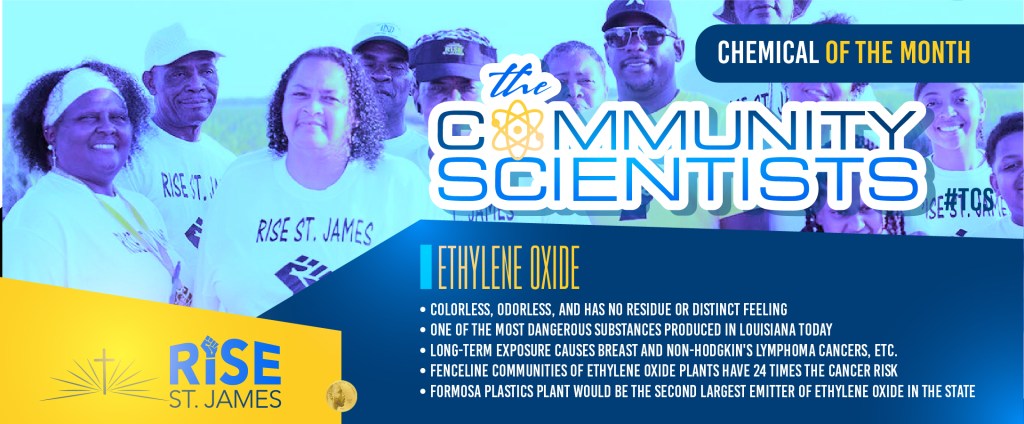CHEMICAL OF THE MONTH – Ethylene Oxide A program of RISE St. James; Caitlion O. Hunter, Juris Doctor, Class of 2022, Past President, Loyola Environmental Law Society; Tim Schütz, PhD Researcher, Anthropology University of California, Irvine; and The Community Scientist (TCS) Research Team
Published 12:00 am Wednesday, August 24, 2022
|
Getting your Trinity Audio player ready...
|
You would never know ethylene oxide is emitted in your community without digging deep into emissions permits, or maybe if your community was contacted by the EPA recently for a community meeting. It is colorless, odorless, and has no residue or distinct feeling when inhaled. But it is one of the single most dangerous substances produced in Louisiana today.
Ethylene oxide was classified as a carcinogen by the International Agency for Research on Cancer back in 1994, but it took the EPA until 2016 to acknowledge the cancer risk and until 2018 to create new restrictions on emissions. In the meantime, facilities in St. Gabriel, St. John the Baptist, and St. Charles parishes were emitting tons of ethylene oxide each year. The EPA only reached out to warn affected Gulf South communities, most of which are majority Black and low-income, last summer. There is no excuse for these decades of silence, and the countless lives affected by the emissions.
Trending
Ethylene oxide therefore remained a silent killer. Long-term exposure causes breast and non-Hodgkin’s lymphoma cancers. St. John Parish has 47 times the national average cancer risk from air pollution, and 12% of that risk is caused by ethylene oxide exposure. There is even evidence that companies, including plants in Louisiana, have fudged their data to “show” they had reduced their ethylene oxide emissions, or that they emitted less in the nearly 25 years that ethylene oxide was known (but somehow not by the EPA) to be carcinogenic.
Ethylene oxide isn’t necessary to power our world, and instead of building more facilities to produce it, we should invest in existing, less harmful alternatives. Its common uses include making polyester fabrics, single use plastics, and antifreeze. But polyester fabrics shed microplastics every time they are worn or washed, and these plastic pieces make their way into our drinking water, our rivers and oceans, and even the air we breathe. Research is ongoing on the effect of microplastics on human health, but microplastics have been shown to interfere greatly with fish and other sea creatures who eat it. In a cruel twist, those who drink bottled water- often out of necessity, since toxic industries have polluted the local water supply- drink about 25 times more microplastics than those whose communities can provide clean tap water. Speaking of bottled water, ethylene oxide is also a precursor to single use plastics, including those used to make soda and water bottles. We need an investment in safe tap water for everyone, not more microplastic-shedding single use containers.
There’s no need to use ethylene oxide for antifreeze, either. In fact, ethylene oxide-derived antifreezes are deadly to humans and pets when consumed. Non-toxic propylene glycol antifreeze is already made on an industrial scale from soybeans.
Trending
The proposed Formosa Plastics plant’s website itself highlights that ethylene oxide is used to produce polyester and antifreeze, but these are hardly fair trade offs for the enormous health burdens ethylene oxide emissions will impose on St. James and surrounding parishes. The proposed Formosa Plastics plant would be the second largest emitter of ethylene oxide in the state. The ethylene oxide facility is just a mile from the 5th District Elementary School and Mount Cavalry Baptist Church. Fenceline communities of ethylene oxide plants have 24 times the cancer risk compared to the rest of the city. Instead of safe havens of the community, the elementary school and the church will become the most dangerous part of town. Formosa Plastics lied about relocating their ethylene oxide plants further away from the school and church, and this lie fooled the St. James Parish Council when they granted the permit. But Formosa Plastics can’t fool us. Community advocates, air scientists, residents, lawyers, and the EPA all agree- ethylene oxide is not a good neighbor.
HOW TO REDUCE THE NEED FOR ETHYLENE OXIDE
- Fill your closet with clothing made from natural fibers like hemp, linen, and cotton instead of polyester. If buying secondhand, which results in less waste, emissions, and resources overall, avoid used polyester if possible. However, polyester-cotton blends shed less than pure polyester.
- Shift away from single-use plastic bottles. Consider installing a reverse osmosis or other filtration system in your house, if you do not trust the tap water. While still using plastic components, they do not shed microplastics and result in far less plastic waste than using bottles. There are several pitcher-style products that have been proven to remove microplastics from tap water.
- Ask your mechanic or auto supply store to install warning signs about the toxicity of ethylene glycol antifreeze, and choose propylene glycol instead. In Southern climates, there is no benefit to a regular driver using ethylene glycol.
PAID ADVERTISEMENT







